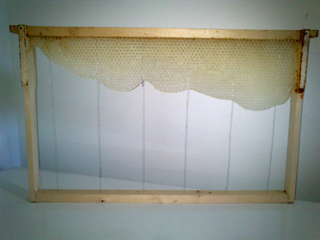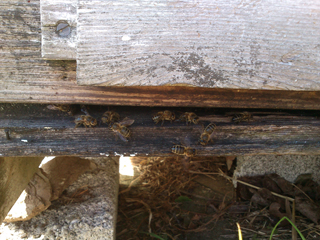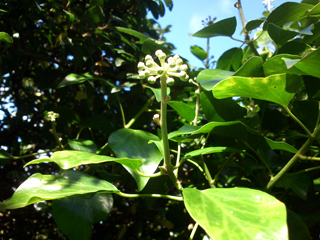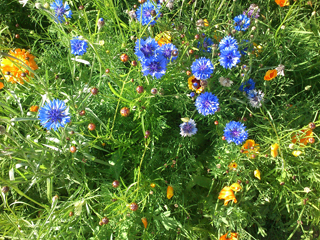 What an August we’ve had – and the last week of July as well! Whilst I was wrong in saying I wouldn’t get a honey crop, what the bees appeared to bring in at the last minute was a fraction of what I normally obtain. Some hives produced a few full combs of honey, others brought in nothing for harvesting, and whilst I do not yet know if this is typical across Cornwall I do know that Scotland has had a very poor harvest. So why is this?
What an August we’ve had – and the last week of July as well! Whilst I was wrong in saying I wouldn’t get a honey crop, what the bees appeared to bring in at the last minute was a fraction of what I normally obtain. Some hives produced a few full combs of honey, others brought in nothing for harvesting, and whilst I do not yet know if this is typical across Cornwall I do know that Scotland has had a very poor harvest. So why is this?
I lay the blame on the weather, as it has not been consistently hot enough for the flowers to yield their nectar. Yes, we’ve had some very nice weather, thank you very much, but plants (trees and shrubs, as well as flowers) can be very fickle sometimes and won’t yield nectar if it’s too hot, too dry, too wet, too cold – they’re very fussy! But a small number of my hives did manage to produce a few combs worth of honey, so how did they manage that?
 I guess it’s down to what I said last month, namely, that the bees in those hives that yielded no surplus honey for me had used up most of their brood box stores to keep themselves and their brood alive, thus emptying the brood chamber. When the plants were finally able to yield some nectar, it all went into the brood boxes of those hives, with none making its way up into the supers from which I take my harvest.
I guess it’s down to what I said last month, namely, that the bees in those hives that yielded no surplus honey for me had used up most of their brood box stores to keep themselves and their brood alive, thus emptying the brood chamber. When the plants were finally able to yield some nectar, it all went into the brood boxes of those hives, with none making its way up into the supers from which I take my harvest.
The colonies that produced just those few combs of honey were presumably more abstemious in their use of their stores during the times of dearth and so were not running on low fuel tanks, so to speak. Ah well! At least I have plenty of bees, and many strong colonies, all of which are in good health.
Having said that, I did have a very strong colony in my jumbo Langstroth hive – you remember, the polystyrene hive that I was trying out for comparison purposes? Well, I had been feeding them from the start, as they were a swarm hived on basically empty frames, and they in turn had been drawing comb down from the wax foundation strips I had attached to the top bars. And a very good job they had done of that as well, nearly all the frames having been drawn down into comb and as straight as a die.
 Then one day I noticed a lack of activity at the entrance, which was totally unlike them and had not been the case the previous day. On further investigation it turned out the hive was totally empty – of bees, brood, pollen and honey! – what is termed a “Marie Celeste” hive amongst beekeepers, as it does happen from time to time. Where they went, why they went, and even how they went without my seeing them go is a mystery.
Then one day I noticed a lack of activity at the entrance, which was totally unlike them and had not been the case the previous day. On further investigation it turned out the hive was totally empty – of bees, brood, pollen and honey! – what is termed a “Marie Celeste” hive amongst beekeepers, as it does happen from time to time. Where they went, why they went, and even how they went without my seeing them go is a mystery.
Was it shortage of food (I was feeding them from the start and there was a good nectar flow on at the time)? Was it possibly disease (unlikely, as they had been treated for Varroa and the brood appeared to be healthy, with no signs even of Chalk Brood, quite a rare scenario here in Cornwall)? Was it the polystyrene hive itself that they didn’t like (unlikely again, as they had stayed long enough to draw all those frames into combs)? It might have been that the hive became too hot for them after they had drawn all that comb, though on an open mesh floor I think that is unlikely as well.
I really do not know and to this day I do not have any of the answers to these questions, so cannot even assess whether the hive was a contributory factor or not. It just serves to remind me that we are not “beekeepers”, we are “bee husbanders”, i.e. we look after those bees which deign to remain in our hives and in our apiaries but have no jurisdiction over whether they actually will remain or not. As my (Welsh) 12 year old grandson said when Wales lost to England a while back – “I’m gutted!”.
 The good news is that the bees in the other new hive I acquired this year, the “Commercial” hive, with bigger combs than the standard hives most commonly in use in the UK, are going great guns. They are drawing comb into the frames and appear very happy with their lot. Let’s hope this continues to be the case, otherwise I might have to take up stamp collecting as a hobby.
The good news is that the bees in the other new hive I acquired this year, the “Commercial” hive, with bigger combs than the standard hives most commonly in use in the UK, are going great guns. They are drawing comb into the frames and appear very happy with their lot. Let’s hope this continues to be the case, otherwise I might have to take up stamp collecting as a hobby.
I have also heard from those new beekeepers who bought nuclei from me earlier in the summer. They are all doing well, developing rapidly and bringing in (or were, when the flow was on) nectar and pollen to equip the hive for its rapid growth before the autumn proper sets in.
It’s always good to hear positive feed-back, something we rarely have time for in this digital age of constantly being “in touch”, as mostly when we look at reviews of products, medical scenarios, hotels, B&Bs, etc the only ones ever reported, (generally) are the bad ones. We expect things/stuff/services to be good, so don’t bother reporting that. So my beekeepers have done me proud in sharing their delight with me in the progress of their new charges and I am equally as delighted as they are.
 The season is coming to an end now. The bees have nothing to do at the moment other than gather on their alighting boards and chew the cud over the season that has passed whilst waiting for the onset of the ivy flow. This should not be too long in the coming, as the flower buds are growing by the day. And one day soon I hope to walk into my apiary and see, hear and smell the frenetic activity that heralds this final blossoming of the year, the time when the bees bring in their winter stores and I know all will be well with the bees until I reintroduce myself to them in the Spring.
The season is coming to an end now. The bees have nothing to do at the moment other than gather on their alighting boards and chew the cud over the season that has passed whilst waiting for the onset of the ivy flow. This should not be too long in the coming, as the flower buds are growing by the day. And one day soon I hope to walk into my apiary and see, hear and smell the frenetic activity that heralds this final blossoming of the year, the time when the bees bring in their winter stores and I know all will be well with the bees until I reintroduce myself to them in the Spring.
Having said all that, swarms might still issue from some colonies – 3 years ago I collected two swarms in St Mawes and one in Pendower in the last two days of September! So continue to keep your eyes and ears open for the sight and sound of late swarms – and please phone me, so I can arrange for their collection by a local beekeeper. Late swarms can still be brought up to strength for the winter if the beekeeper knows what s/he is about but will perish if left to their own devices, whether in the wild or in some inside cavity such as a house roof, chimney or shed.
Colin Rees – 01872 501313 – colinbeeman@aol.com

